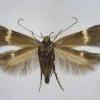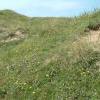35.004 Aproaerema taeniolella (Zeller, 1839)
Status and Distribution
Widespread but rather local, occasionally locally common, across lowland parts of England and Wales. Very local in Ireland and Northern England, only recorded on Barra in Scotland*, and unrecorded from Northern Ireland and Isle of Man. It appears to be restricted to coastal localities in the more northerly parts of Britain.
* Details of supporting records for VC83 and VC113, shown as dots on the national VC maps, are unknown to this Scheme. That for VC101 actually relates to VC110 (R. Heckford pers. comm., 2020) - there are no known records from VC101.

Provisional map
Pupa
Set Specimens
The white marks on the upperside and underside of the forewing and hindwing of A. taeniolella are usually as shown above. Forms of A. taeniolella can occur with a broken and narrowed upperwing fascia and, in one specimen of this type, the underside white area of the forewing was restricted to a blotch on the costa with no white marks at all on the underside of the hindwing. In another form, the forewing upperside white fascia is completely obsolescent, with two such specimens having no underside white markings either - it is not known if this is always the case.
Foodplant and Larval Feeding Signs
Lotus corniculatus (common bird's-foot-trefoil), see plant distribution map. Very occasionally on Lotus pedunculatus (greater bird's-foot-trefoil), Trifolium spp. (clover) and Medicago spp. (medick). It was once reported from Helianthemum nummularium (common rock-rose) by P. Sokoloff in the BENHS Journal of 1980: 8, an extremely unusual choice of foodplant.
In Europe also found on Chrysapsis micrantha, Dorycnium, Medicago minima (bur medick), Tetragonolobus maritimus, Trifolium medium (zigzag clover) and Trifolium pratense (red clover).
Finding the Moth
Larva: spins leaves together and feeds within the spinning. Syncopacma cinctella also utilises common bird's-foot-trefoil and S. larseniella has been known to use it on rare occasions.
Adult: easily disturbed on warm days and swept from amongst the larval foodplant. Comes to light.
Similar Species
Readily separated from other Aproaerema species with a white, upperside, forewing fascia by the presence of a similar, slightly thinner fascia on the underside of the forewing and a white costal spot on the underside of the hindwing; these features are absent in other species. See photograph of upperside and underside of the forewings in the 'Images' section and the comparable markings of A. larseniella under that species.
Infrequently, the white fascia on the upperside of the forewing can be broken, reduced to a few dots or even absent. In the latter case it appears that the underside white markings are also absent.
It should be noted that A. cinctella and, rarely, A. larseniella, can lack the white fascia on the upperside of the forewing. If checking of the underside of the forewing fails to show any obvious white fascia then dissection is recommended to enable identification to species level.
The pale fascia on A. taeniolella can be straight or, more often, slightly inwardly curved.
For more detailed discussion covering the Aproaerema species and their separation see under A. cinctella (Finding the Moth / Similar Species).
Single brooded from mid-June to August.











